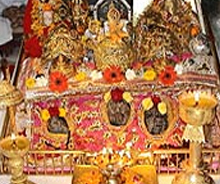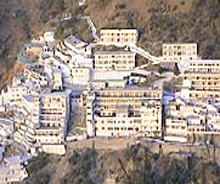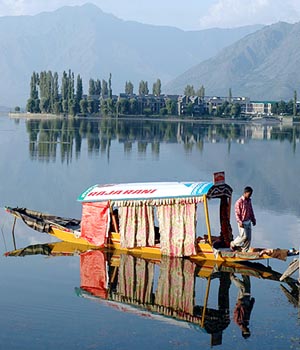|
A
Legend
A land of grand ancient temples, and beautiful palaces, all
nestling in the foothills of the Himalayas. It is said that, on
becoming King, the Suryavanshi Jambu Lochan went on a hunt and,
crossing the Tawi, found a deer and a tiger drinking water from
the same tank. His ministers explained that this meant that the
soil of the place was so virtuous that no living creature bore
enmity against another.
Raja Jambu Lochan, who lived in the later Vedic period, decided to
found his capital , Jambupura, on his soil, on the right bank of
the Tawi, overlooking his brother king Bahu's fort. Today the
temple of Maha Kali, better known as "Bahu" or "Bawey Wali Mata",
located in the Bahu Fort, is considered second only to Mata
Vaishno Devi in terms of mystical power. The present temple was
built shortly after the coronation of Maharaja Gulab Singh, in
1822. The existing fort, as well as the Manasabdar's palace inside
it, was constructed in 1820.
History
Legend has it that Jamboo Loochen founded the city about three
thousand years ago. The Raja was hunting in the area, away from
his capital city of Bahu when he came across a lion and a goat
drinking from the same pond. The Shivadawala Shrine now stands on
this spot in the city. Jammu is known as 'the city of temples'
because of its many shrines, with their soaring golden spires or 'Shikhars'
Shri Mata
Vaishno Devi Ji
A pilgrimage to the H oly
Shrine of Shri Mata Vaishno Devi Ji is considered to be one of the
holiest pilgrimages of our times. Popular the world over as Moonh
Maangi Muradein Poori Karne Wali Mata, which means, the Mother who
fulfills whatever Her children wish for, Shri Mata Vaishno Devi Ji
resides in a Holy Cave located in the folds of the three peaked
mountain named Trikuta (pronounced as Trikoot). The Holy Cave
attracts lakhs of devotees every year. In fact, the number of
Yatris visiting the Holy Shrine annually now exceeds 5 million.
This is due to the unflinching faith of the devotees who throng
the Shrine from all parts of India and abroad. oly
Shrine of Shri Mata Vaishno Devi Ji is considered to be one of the
holiest pilgrimages of our times. Popular the world over as Moonh
Maangi Muradein Poori Karne Wali Mata, which means, the Mother who
fulfills whatever Her children wish for, Shri Mata Vaishno Devi Ji
resides in a Holy Cave located in the folds of the three peaked
mountain named Trikuta (pronounced as Trikoot). The Holy Cave
attracts lakhs of devotees every year. In fact, the number of
Yatris visiting the Holy Shrine annually now exceeds 5 million.
This is due to the unflinching faith of the devotees who throng
the Shrine from all parts of India and abroad.
The Holy Cave of the Mother is situated at an altitude of 5200 ft.
The Yatris have to undertake a trek of nearly 12 km from the base
camp at Katra. At the culmination of their pilgrimage, the yatries
are blessed with the Darshans of the Mother Goddess inside the
Sanctum Sanctorum- the Holy Cave. These Darshans are in the shape
of three natural rock formations called the Pindies. There are no
statues or idols inside the Cave.
Darshans are open round the clock throughout the year.
 Since
the year 1986, when the Shri Mata Vaishno Devi Shrine Board
(commonly called Shrine Board) was formed (under “The Jammu &
Kashmir Shri Mata Vaishno Devi Shrine Act, 1986’), the management
of the Shrine and regulation of the Yatra has been vested in the
Board. The Board has undertaken a number of developmental
activities aimed at making the Yatra a comfortable and satisfying
experience for the Yatris. So far, over 125 crores of rupees have
been invested by the Board for providing various infrastructural
and other facilities. The Board continues to reinvest the
offerings and donations received in carying out improvements in
various kinds of Yatri facilities. Since
the year 1986, when the Shri Mata Vaishno Devi Shrine Board
(commonly called Shrine Board) was formed (under “The Jammu &
Kashmir Shri Mata Vaishno Devi Shrine Act, 1986’), the management
of the Shrine and regulation of the Yatra has been vested in the
Board. The Board has undertaken a number of developmental
activities aimed at making the Yatra a comfortable and satisfying
experience for the Yatris. So far, over 125 crores of rupees have
been invested by the Board for providing various infrastructural
and other facilities. The Board continues to reinvest the
offerings and donations received in carying out improvements in
various kinds of Yatri facilities.
Indian Spiritual tradition has propounded four Purusharth
(objectives) of a human life. These being Dharm (Righteousness),
Arth (Material Pursuits), Kaam (Contentment) and Moksh
(Enlightenment). Shri Mata Vaishno Devi is believed to grant all
the four boons to those who visit Her Holy Shrine. She is
considered to fulfill anything and everything that a person wishes
for in life, in a righteous way. It is an experience of all, that
no one goes empty handed from Her Great Pilgrimage.
The journey to the Holy Shrine of Mata Vaishno Devi is thus an
enchanting journey of the places where Mata Vaishnavi had spent
some time while observing various spiritual disciplines and
penances. The culmination of this journey is at the Holy Cave
where She merged Her Human form with the astral form of Her
creators, the three Supreme Energies
History of the Holy Shrine...
History of the Shrine
Like with most old Shrines, it is not possible to ascertain when
exactly the pilgrimage to the Holy Shrine started. A geological
stu dy
of the Holy Cave has indicated its age to be nearly a million
years. Vedic literature gives no reference to the worship of any
female deity, although the mountain Trikuta does find its mention
in Rigveda, the oldest of the four Vedas The practice of
worshipping Shakti, largely started in the Puranic period. dy
of the Holy Cave has indicated its age to be nearly a million
years. Vedic literature gives no reference to the worship of any
female deity, although the mountain Trikuta does find its mention
in Rigveda, the oldest of the four Vedas The practice of
worshipping Shakti, largely started in the Puranic period.
Discovery of the Shrine
While various versions of the origin and legend of Shri Mata
Vaishno Devi Ji are prevalent, there seems to be unanimity on the
discovery of Shrine around 700 years back by the same Pandit
Shridhar, at whose place Mata had helped organize a Bhandaara.
When she left amidst the Bhandaara to escape Bhairon Nath, Pandit
Shridhar is said to have felt as if he had lost everything in his
life. He felt immense grief and gave up the intake of food or even
water and closed himself in a room of his house, fervently praying
for Vaishnavi to reappear .
|


 oly
Shrine of Shri Mata Vaishno Devi Ji is considered to be one of the
holiest pilgrimages of our times. Popular the world over as Moonh
Maangi Muradein Poori Karne Wali Mata, which means, the Mother who
fulfills whatever Her children wish for, Shri Mata Vaishno Devi Ji
resides in a Holy Cave located in the folds of the three peaked
mountain named Trikuta (pronounced as Trikoot). The Holy Cave
attracts lakhs of devotees every year. In fact, the number of
Yatris visiting the Holy Shrine annually now exceeds 5 million.
This is due to the unflinching faith of the devotees who throng
the Shrine from all parts of India and abroad.
oly
Shrine of Shri Mata Vaishno Devi Ji is considered to be one of the
holiest pilgrimages of our times. Popular the world over as Moonh
Maangi Muradein Poori Karne Wali Mata, which means, the Mother who
fulfills whatever Her children wish for, Shri Mata Vaishno Devi Ji
resides in a Holy Cave located in the folds of the three peaked
mountain named Trikuta (pronounced as Trikoot). The Holy Cave
attracts lakhs of devotees every year. In fact, the number of
Yatris visiting the Holy Shrine annually now exceeds 5 million.
This is due to the unflinching faith of the devotees who throng
the Shrine from all parts of India and abroad. Since
the year 1986, when the Shri Mata Vaishno Devi Shrine Board
(commonly called Shrine Board) was formed (under “The Jammu &
Kashmir Shri Mata Vaishno Devi Shrine Act, 1986’), the management
of the Shrine and regulation of the Yatra has been vested in the
Board. The Board has undertaken a number of developmental
activities aimed at making the Yatra a comfortable and satisfying
experience for the Yatris. So far, over 125 crores of rupees have
been invested by the Board for providing various infrastructural
and other facilities. The Board continues to reinvest the
offerings and donations received in carying out improvements in
various kinds of Yatri facilities.
Since
the year 1986, when the Shri Mata Vaishno Devi Shrine Board
(commonly called Shrine Board) was formed (under “The Jammu &
Kashmir Shri Mata Vaishno Devi Shrine Act, 1986’), the management
of the Shrine and regulation of the Yatra has been vested in the
Board. The Board has undertaken a number of developmental
activities aimed at making the Yatra a comfortable and satisfying
experience for the Yatris. So far, over 125 crores of rupees have
been invested by the Board for providing various infrastructural
and other facilities. The Board continues to reinvest the
offerings and donations received in carying out improvements in
various kinds of Yatri facilities. dy
of the Holy Cave has indicated its age to be nearly a million
years. Vedic literature gives no reference to the worship of any
female deity, although the mountain Trikuta does find its mention
in Rigveda, the oldest of the four Vedas The practice of
worshipping Shakti, largely started in the Puranic period.
dy
of the Holy Cave has indicated its age to be nearly a million
years. Vedic literature gives no reference to the worship of any
female deity, although the mountain Trikuta does find its mention
in Rigveda, the oldest of the four Vedas The practice of
worshipping Shakti, largely started in the Puranic period.